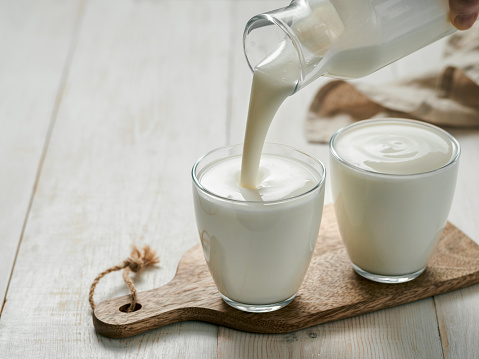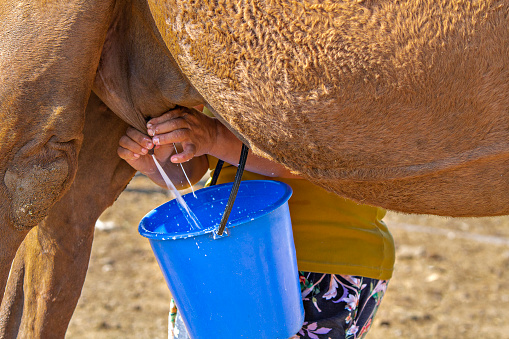Camel Milk; A Superfood for Cardiovascular Issues!

camel milk
The following scientifically defined how camel milk is effective on cardiovascular issues!
Particular probiotic bacteria and hypocholesterolemia peptides of camel milk prevent the reabsorption of cholesterol from the intestine by deconjugating bile salts, reducing cholesterol’s micellar solubility, and inhibiting cholesterol absorption.
Camel milk and cardiovascular failures
In rats, fermented camel milk has hypocholesterolemic effects; that is still unclear. But maybe, the interaction between bioactive peptides of camel milk and cholesterol decreases cholesterol. According to other research, the presence of orotic acid produced from the nucleic acid metabolism is responsible for the lowering of cholesterol amount in rats and humans who consume camel milk.
The administration of camel milk for five weeks showed a significant decrease in the total cholesterol from 6.17 to 4.35 mmol. l-1. Researchers concluded that the using of camel milk for 45 days significantly decreased hyperlipidemia, total cholesterol, triacylglycerol, free fatty acid, LDL, and VLDL in plasma, liver, heart, and kidney to normal levels. Also, after consumption of camel milk, the content of HDL significantly improved. Other researchers recently reported the hypocholesterolemic effect of fermented camel milk or Garissa. After consuming camel milk for six months, the amounts of LDL and triacylglycerol reduced in type 1 diabetic cases.
According to research, a 1 % reduction in serum cholesterol leads to a 2 to 3 % reduction in the risk of cardiovascular diseases. Studies have reported the effects of lowering blood cholesterol by fermented dairy products in humans and animals; but the cholesterol-lowering mechanism is unknown.

Probiotic bacteria and bioactive peptides produced by their proteolytic activity have hypocholesterolemic effects. Probiotic bacteria ferment indigestible carbohydrates and produce short-chain fatty acids in the gut that affect hepatic cholesterol synthesis and cholesterol distribution from plasma to the liver. Probiotic bacteria also interfere with the absorption of cholesterol from the intestine by deconjugating bile salts and preventing reabsorption or direct absorption of cholesterol.
Cholesterol-lowering peptides also reduce cholesterol by binding to cholesterol by electrostatic and hydrophobic reactions or by lowering the micellar solubility of cholesterol and inhibiting cholesterol absorption. The decrease in cholesterol levels may also be due to the direct interaction of arginine and tyrosine with the cholesterol and the formation of the apoprotein-cholesterol complex, which is dependent on the amount of arginine in the protein.

Recent studies have shown that non-hydrolyzed casein does not affect lowering cholesterol; However, compounds obtained by casein hydrolysis by Bb12 or trypsin and Bb12 reduced cholesterol levels by 24 to 87 %. This bacteria in milk converts casein into peptides that lower cholesterol. There may also be a synergistic effect between peptides and bacterial culture in lowering cholesterol, and Bb12 bacteria culture and its peptides had a more significant cholesterol-lowering effect than peptides alone.
According to studies, fermented dairy products are recommended as a dietary supplement due to their hypocholesterolemic effect in humans and mice. Buffalo yogurt contains Bifidobacterium that lowers plasma and liver cholesterol levels. Most research has been done to study fermented products, especially cow’s milk yogurt, in reducing cholesterol by using Bifidobacterium bifidum, Bifidobacterium langue, and Lactobacillus acidophilus; However, the mechanism of lowering of cholesterol by camel milk is still unclear.
Fermented milk and whey protein of camel milk contains angiotensin-converting enzyme-inhibiting peptides, which regulate blood pressure that is produced by the proteolytic digestion of casein and whey proteins. Of course, this peptide is resistant to enzymatic proteases and heat; But more research is needed to confirm its effects.
The C-terminal sequence of these peptides binds to the active site of this enzyme and inhibits its activity. Also, the cholesterol-lowering effects of camel milk proteins may be due to other factors, such as cysteine, insulin-like proteins in whey proteins, and small size immunoglobulins.
The Lactobacillus helveticus 130B4 releases the angiotensin-converting enzyme-inhibiting peptide (ACE) from camel milk proteins. After enzymatic hydrolysis of camel milk proteins, the ACE inhibitory activity of total casein and beta-casein increased. Whole casein and beta-casein in camel milk had high ACE inhibitory activity after hydrolysis with pepsin, trypsin, and chymotrypsin.
ACE inhibitory activity was higher in cultured camel milk than in cow milk, which may be due to structural differences and higher proline in the initial structure of camel milk casein than in cow milk. Lactic acid bacteria produce ACE inhibitors from camel’s milk that effectively maintain health. These inhibitors are obtained from the fermentation of milk by the Lactobacillus delbruki, Lactobacillus bulgaricus, Lactobacillus helveticus, Saccharomyces cerevisiae, and Lactococcus lactis.
Oxidative stress and subsequent damages occur when antioxidant defense mechanisms cannot cope with endogenous or external sources of reactive oxygen species (ROS). Increased oxidative stress may lead to diabetes mellitus and complications like vascular and . Therefore, control of ROS production is essential for the physiological function of the cell.
Conclusion
Using camel milk for six months reduced LDL and triacylglycerols in type 1 diabetic cases. A reduction of 1% in cholesterol level reduces the risk of cardiovascular diseases by 2–3%. Therefore, camel milk is not only food but also recommended as a superfood for heart health and cardiovascular disorders. More scientific studies are needed to confirm the effectiveness of camel milk on heart health.
References
1. Agrawal., R.P. R. Dogra, N. Mohta, R. Tiwari, S. Singhal, and S Sultania. 2009. Ben¬eficial effect of camel milk in diabetic nephropathy. Acta Biomed 80(2):131–4.
2. Alhaj., O.A. A. Kanekanian, A. Peters. 2006. The effect of Bifidobacterium lactic and trypsin on cholesterol. In: International Food and Health Innovation Conference, Malmö, Skane Food Innovation Network, Sweden.
3. Ali., A.F. Iqbal, A. Taj, Z. Iqbal, M. J. Amin, Q. Z. Iqbal. 2013.Prevalence of microvascular complications in newly diagnosed patients with type 2 diabetes. PAKISTAN Journal of MEDICAL Science, 29: 899 – 902
4. Ali., A.A. A.A. Alyan,and A.S Bahobail. 2013. Effect of fermented camel milk and cow milk containing (bifidobacteria) enriched diet in rats fed on cholesterol level: the Agricultural Science Research Journal, 3:342e6.
5. Al-Numair. K.S. 2010. Type II diabetic rats and the hypolipidemic effect of camel milk. Journal of Food, Agriculture, and Environment. 8:77e81.
6. Elayan., A.A, A.E Sulieman, and F.A. Saleh. 2008. The hypocholesterolemic effect of Garissa and Garissa containing Bifid bacteria in rats fed on a cholesterol-enriched diet. Asian Journal of Biochemistry, 3: 43-47.
7. Kawase. M. Effect of administration of fermented milk containing whey protein concentrate to rats and healthy men on serum lipids and blood pressure. Journal Dairy Science.2000;83(2):255-63.
8. Korish. A.A. 2014.The antidiabetic action of camel milk in experimental type 2 diabetes mellitus: an overview on the changes in incretin hormones, insulin resistance, and inflammatory cytokines. Hormone and Metabolic Research Impact Factor,46:404–11.
9. Li H, Papadopoulos V. 1998. Peripheral-type benzodiazepine receptor function in cholesterol transport. Identification of a putative cholesterol recognition/interaction amino acid sequence and consensus pattern. Endocrin 139: 4991-4997.
10. Moreno-Navarrete JM, Ortega FJ, Bassols J, et al. 2009.Decreased circulating lactoferrin in insulin resistance and altered glucose tolerance as a possible marker of neutrophil dysfunction in type 2 diabetes. J Clin Endocrinol Metab; 94:4036–44.
11. Quan., S.H. Tsuda,and T. Miyamoto. 2008. Angiotensin I-converting enzyme inhibitory peptides in skim milk fermented with Lactobacillus helveticus 130B4 from camel milk in Inner Mongolia, China Juornal Science Food Agriculture ,88: 2688- 2692.
12. Shori. A.B.2015. Camel milk as a potential therapy for controlling diabetes and its complications: A review of in vivo studies. The World Journal of Pharmaceutical Sciences, 23: 609-618.

















